Non-Similar Solution of G-jitter Induced Unsteady Magnetohydrodynamic Radiative Slip Flow of Nanofluid
Abstract
Featured Applications
Abstract
1. Introduction
2. Description and Formulation of the Governing Equations
3. Physical Quantities
4. Computational Solution of Nonlinear Boundary Value Problem
5. Illustration of the Results and Interpretation
6. Conclusions
- (i)
- In the case of stationary free stream, surface friction rises with Darcy number, whereas, it reduces with magnetic field and time.
- (ii)
- In the case of moving free stream, friction decreases with Darcy number and time; however, it increases with the magnetic field.
- (iii)
- Increasing velocity slip reduces friction factor, whereas, the mixed convection and frequency parameters lead to an increase in friction for both moving and stationary free streams.
- (iv)
- Heat transfer rates rise with greater values of mixed convection, velocity slip, and frequency; conversely, they reduce with greater thermophoresis, thermal slip, and conduction-radiation (i.e., lower radiative flux) parameters for both moving and stationary free streams.
- (v)
- In the case of moving (stationary) free stream, the heat transfer rate decreases (increases) with an increase in the Darcy number.
- (vi)
- In the case of moving (stationary) free stream, the heat transfer rate increases (decreases) with greater magnetic field parameter.
Author Contributions
Funding
Conflicts of Interest
Nomenclature
| a | constant (1/s) |
| strength of magnetic field (Wb/m2) | |
| specific heat at constant pressure (kJ/kg-K) | |
| nanoparticle volume fraction (-) | |
| friction factor (-) | |
| wall nanoparticle volume fraction (-) | |
| Surrounding nanoparticle volume fraction (-) | |
| Brownian diffusion coefficient (m2/s) | |
| thermophoretic diffusion coefficient (m2/s) | |
| Darcy number (-) | |
| stream function (-) | |
| the gravitational acceleration (m/s2) | |
| time-averaged value of the gravitational acceleration (m/s2) | |
| thermal conductivity (W/m-K) | |
| permeability (m2) | |
| unit vector | |
| constant reflecting pressure gradient term (-) | |
| L | characteristic length (m) |
| Le | Lewis number (-) |
| M | magnetic field parameter (-) |
| Brownian motion parameter (-) | |
| buoyancy ratio parameter (-) | |
| thermophoresis parameter (-) | |
| local Nusselt number (-) | |
| Prandtl number (-) | |
| wall mass flux (m/s) | |
| radiative heat flux (J/m2-s) | |
| wall heat flux (W/m2) | |
| Radiation-conduction parameter (-) | |
| Reynolds number (-) | |
| local Reynolds number (-) | |
| local Sherwood number (-) | |
| time (s) | |
| temperature (K) | |
| temperature ratio parameter (K) | |
| sheet temperature (K) | |
| ambient temperature (K) | |
| velocity component along the x-axis (m/s) | |
| velocity component along the y-axis (m/s) | |
| external velocity (m/s) | |
| Rectangular coordinates lengthwise and perpendicular to the plate (m) | |
| Greek symbols | |
| thermal diffusivity of the fluid (m2/s) | |
| thermal expansion coefficient (1/K) | |
| coefficient of mass expansion (-) | |
| velocity slip parameter (-) | |
| thermal slip parameter (-) | |
| frequency of oscillation (1/s) | |
| non-dimensional frequency (-) | |
| mixed convection parameter (-) | |
| similarity independent variable (-) | |
| non-dimensional temperature (-) | |
| nanoparticle volume fraction (-) | |
| dynamic viscosity of the fluid (Ns/m2) | |
| kinematic viscosity of the fluid (m2/s) | |
| density of the base fluid (kg/m3) | |
| volumetric heat capacity of the fluid (J/m3-K) | |
| volumetric heat capacity of the nanoparticle material (J/m3-K) | |
| electric conductivity (Siemens/m) | |
| Stefan-Boltzmann constant (W/m2-K4) | |
| ratio of the effective heat capacity of the nanoparticle to the fluid heat capacity (-) | |
| stream function (m2/s) | |
| Subscripts | |
| denotes ordinary differentiation with respect to | |
References
- Amin, N. The effect of g-jitter on heat transfer. Proc. R. Soc. Lond. A 1988, 419, 151–172. [Google Scholar]
- Chen, H.; Saghir, M.Z.; Quon, D.H.H.; Chehab, S. Numerical study on transient convection in float zone induced by g-jitter. J. Cryst. Growth 1994, 142, 362. [Google Scholar] [CrossRef]
- Li, B.Q. G-Jitter induced free convection in a transverse magnetic field. Int. J. Heat Mass Transf. 1996, 39, 2853–2860. [Google Scholar] [CrossRef]
- Rees, D.A.S.; Pop, I. The effect of g-jitter on vertical free convection boundary-layer flow in porous media. Int. Commun. Heat Mass Transf. 2000, 27, 415–424. [Google Scholar] [CrossRef]
- Rees, D.A.S.; Pop, I. g-Jitter induced free convection near a stagnation point. Heat Mass Transf. 2001, 37, 403–408. [Google Scholar] [CrossRef]
- Rees, D.A.S.; Pop, I. The effect of large-amplitude g-jitter vertical free convection boundary-layer flow in porous media. Int. J. Heat Mass Transf. 2003, 46, 1097–1102. [Google Scholar] [CrossRef]
- Shu, Y.; Li, B.Q.; De Groth, H.C. Numerical study of g-jitter induced double-diffusive convection. Numer. Heat Transf. Part A Appl. 2001, 39, 245–265. [Google Scholar]
- Shu, Y.; Li, B.Q.; de Groh, H.C. Magnetic damping of g-jitter induced double-diffusive convection. Numer. Heat Transf. Part A Appl. 2002, 42, 345–364. [Google Scholar] [CrossRef]
- Amin, N.; Shafie, S.; Pop, I. The effect of g-jitter on double diffusion by natural convection from a sphere. Int. J. Heat Mass Transf. 2005, 48, 4526–4540. [Google Scholar]
- Sharidan, S.; Amin, N.; Pop, I. G-jitter induced free convection near a two-dimensional stagnation point in micropolar fluids. Int. J. Appl. Mech. Eng. 2005, 10, 311–328. [Google Scholar]
- Pop, I.; Shafie, S.; Amin, N. g-Jitter free convection flow in the stagnation-point region of a three-dimensional body. Mech. Res. Commun. 2007, 34, 115–122. [Google Scholar]
- Suthar, O.P.; Bhadauria, B.S.; Khan, A. Effect of G-jitter on the onset of thermosolutal viscoelastic convection in the absence of local thermal equilibrium. Spec. Top. Rev. Porous Med. 2012, 3, 239–246. [Google Scholar] [CrossRef]
- Rawi, N.A.; Ilias, M.R.; Isa, Z.M.; Shafie, S. G-Jitter induced mixed convection flow and heat transfer of micropolar nanofluids flow over an inclined stretching sheet. AIP Conf. Proc. 2016, 1775, 030020. [Google Scholar]
- Afiqah, R.N.; Rijal, I.M.; Mahat, R.; Mat, I.Z.; Shafie, S. G-jitter induced mixed convection flow of a second-grade fluid past an inclined stretching sheet. In Proceedings of the MATEC Web of Conferences, Beijing, China, 25–27 May 2018; Volume 189, p. 01006. [Google Scholar]
- Yih, K. Radiation effect on mixed convection over an isothermal wedge in porous media: The entire regime. Heat Transf. Eng. 2001, 22, 26–32. [Google Scholar] [CrossRef]
- Zhang, C.; Zheng, L.; Zhang, X.; Chen, G. MHD flow and radiation heat transfer of nanofluids in porous media with variable surface heat flux and chemical reaction. Appl. Math. Model. 2015, 39, 165–181. [Google Scholar] [CrossRef]
- Mahapatra, T.R.; Nandy, S.K.; Gupta, A.S. Oblique stagnation-point flow and heat transfer towards a shrinking sheet with thermal radiation. Meccanica 2012, 147, 1325–1335. [Google Scholar] [CrossRef]
- Ozisik, M.N. Interaction of Radiation with Convection. In Handbook of Single Phase Convective Heat Transfer; John Wiley & Sons: New York, NY, USA, 1987. [Google Scholar]
- Dehghan, M.; Rahmani, M.Y.; Ganji, D.D.; Saedodin, S.; Valipour, M.S.; Rashidi, S. Convection–radiation heat transfer in solar heat exchangers filled with a porous medium: Homotopy perturbation method versus numerical analysis. Renew. Energy 2015, 74, 448–455. [Google Scholar] [CrossRef]
- Hernández, V.R.; Zueco, J. Network numerical analysis of radiation absorption and chemical effects on unsteady MHD free convection through a porous medium. Int. J. Heat Mass Transf. 2013, 64, 375–383. [Google Scholar] [CrossRef]
- Vafai, K.; Tien, C.L. Convective and radiative heat transfer in porous media. Adv. Appl. Mech. 1989, 27, 225–281. [Google Scholar]
- Takhar, H.S.; Bég, O.A.; Kumari, M. Computational analysis of coupled radiation convection dissipative flow in a porous medium using the Keller-Box implicit difference scheme. Int. J. Energy Res. 1988, 22, 141–159. [Google Scholar] [CrossRef]
- Motsumi, T.G.; Makinde, O.D. Effects of thermal radiation and viscous dissipation on boundary layer flow of nanofluids over a permeable moving flat plate. Phys. Scr. 2012, 86, 045003. [Google Scholar] [CrossRef]
- Pantokratoras, A. Natural convection along a vertical isothermal plate with linear and non-linear Rosseland thermal radiation. Int. J. Therm. Sci. 2014, 84, 151–157. [Google Scholar] [CrossRef]
- Cortell, R. Fluid flow and radiative nonlinear heat transfer over a stretching sheet. J. King Saud Univ. Sci. 2014, 26, 161–167. [Google Scholar] [CrossRef]
- Mustafa, M.; Mushtaq, A.; Hayat, T.; Alsaedi, A. Radiation effects in three-dimensional flow over a bi-directional exponentially stretching sheet. J. Taiwan Inst. Chem. Eng. 2015, 47, 43–49. [Google Scholar] [CrossRef]
- Uddin, M.J.; Bég, O.A.; Ismail, A.I.M. Mathematical modeling of radiative hydromagnetic thermosolutal nanofluid convection slip flow in saturated porous media. Math. Probl. Eng. 2014, 11, 179172. [Google Scholar]
- Siddiqa, S.; Hossain, M.A.; Saha, S.C. The effect of thermal radiation on the natural convection boundary layer flow over a wavy horizontal surface. Int. J. Therm. Sci. 2014, 84, 143–150. [Google Scholar] [CrossRef]
- Nield, D.A.; Kuznetsov, A.V. The Cheng-Minkowycz problem for natural convection boundary-layer flow in a porous medium saturated by a nanofluid. Int. J. Heat Mass Transf. 2009, 52, 5792–5795. [Google Scholar] [CrossRef]
- Uddin, M.J.; Khan, W.A.; Ismail, A.I.M. Lie group analysis of natural convective flow from a convectively heated upward-facing radiating permeable horizontal plate in porous media filled with nanofluid. J. Appl. Math. 2012, 2012, 648675. [Google Scholar] [CrossRef]
- Hady, F.M.; Ibrahim, F.S.; Abdel-Gaied, S.M.; Eid, M.R. Boundary-layer non-Newtonian flow over the vertical plate in porous medium saturated with nanofluid. Appl. Math. Mech. 2011, 32, 1577–1586. [Google Scholar] [CrossRef]
- Mahdi, R.A.; Mohammed, H.A.; Munisamy, K.M.; Saeid, N.H. Review of convection heat transfer and fluid flow in porous media with nanofluids. Renew. Sustain. Energy Rev. 2015, 41, 715–734. [Google Scholar] [CrossRef]
- Wang, C.Y. Stagnation flow on a plate with anisotropic slip. Eur. J. Mech. B/Fluids 2013, 38, 73–77. [Google Scholar] [CrossRef]
- Sharipov, F.; Seleznev, V. Data on internal rarefied gas flows. J. Phys. Chem. Ref. Data 1998, 27, 657–706. [Google Scholar] [CrossRef]
- Wang, C.Y. Flow over a surface with parallel grooves. Phys. Fluids 2003, 15, 1114–1121. [Google Scholar] [CrossRef]
- Choi, C.H.; Kim, C.J. Large slip of aqueous liquid flow over a nanoengineered superhydrophobic surface. Phys. Rev. Lett. 2006, 96, 066001. [Google Scholar] [CrossRef]
- Navier, C.L.M. Sur les lois du mouvement des fluids. Mem. Acad. R. Sci. Inst. Fr. 1827, 6, 389–440. [Google Scholar]
- Behzad, M.; Aliakbar, V.; Shams, M.; Moshfegh, A. Heat transfer analysis of a micro-spherical particle in the slip flow regime by considering variable properties. Heat Transf. Eng. 2015, 36, 596–610. [Google Scholar]
- Uddin, M.J.; Khan, W.A.; Amin, N.S. G-Jitter mixed convective slip flow of nanofluid past a permeable stretching sheet embedded in a Darcian porous media with variable viscosity. PLoS ONE 2014, 9, e99384. [Google Scholar] [CrossRef]
- Buongiorno, J. Convective transport in nanofluids. J. Heat Transf. 2006, 128, 240–250. [Google Scholar] [CrossRef]
- Uddin, M.J.; Rana, P.; Bég, O.A.; Ismail, A.M. Finite element simulation of magnetohydrodynamic convective nanofluid slip flow in porous media with nonlinear radiation. Alex. Eng. J. 2016, 55, 1305–1319. [Google Scholar] [CrossRef]
- Kuznetsov, A.V.; Nield, D.A. Natural convective boundary-layer flow of a nanofluid past a vertical plate: A revised model. Int. J. Therm. Sci. 2014, 77, 126–129. [Google Scholar] [CrossRef]
- Sparrow, E.M.; Cess, R.D. Radiation Heat Transfer; Hemisphere: Washington, DC, USA, 1978. [Google Scholar]
- Yih, K.A. The effect of uniform suction/blowing on heat transfer of magnetohydrodynamic Hiemenz flow through porous media. Acta Mech. 1998, 130, 147–158. [Google Scholar] [CrossRef]
- Bellman, R.; Kalaba, R. Quasilinearization, and Nonlinear Boundary Value Problems; RAND Corporation: New York, NY, USA, 1965. [Google Scholar]
- Bég, O.A.; Bhargava, R.; Rashidi, M.M. Numerical Simulation in Micropolar Fluid Dynamics: Mathematical Modelling of Nonlinear Flows of Micropolar Fluids; Lambert Academic Publishing: Saarbrucken, Germany, 2011; 288p. [Google Scholar]
- Sparrow, E.M.; Eckert, E.R.; Minkowycz, W.J. Transpiration cooling in a magnetohydrodynamic stagnation-point flow. Appl. Sci. Res. Sec. A 1962, 11, 125–147. [Google Scholar] [CrossRef]
- Ariel, R.D. Hiemenz flow in hydromagnetics. Acta Mech. 1994, 103, 31–43. [Google Scholar] [CrossRef]
- Lin, H.; Lin, L.K. Similarity solutions for laminar forced convection heat transfer from wedges to fluids of any Prandtl number. Int. J. Heat Mass Transf. 1987, 30, 1111–1118. [Google Scholar] [CrossRef]
- Zueco, J.; Bég, O.A.; Takhar, H.S.; Prasad, V.R. Thermophoretic hydromagnetic dissipative heat and mass transfer with lateral mass flux, heat source, Ohmic heating, and thermal conductivity effects: Network simulation numerical study. Appl. Therm. Eng. 2009, 29, 2808–2815. [Google Scholar] [CrossRef]
- Hossain, M.A.; Alim, M.A.; Rees, D.A.S. The effect of radiation on free convection from a porous vertical plate. Int. J. Heat Mass Transf. 1999, 42, 181–191. [Google Scholar] [CrossRef]
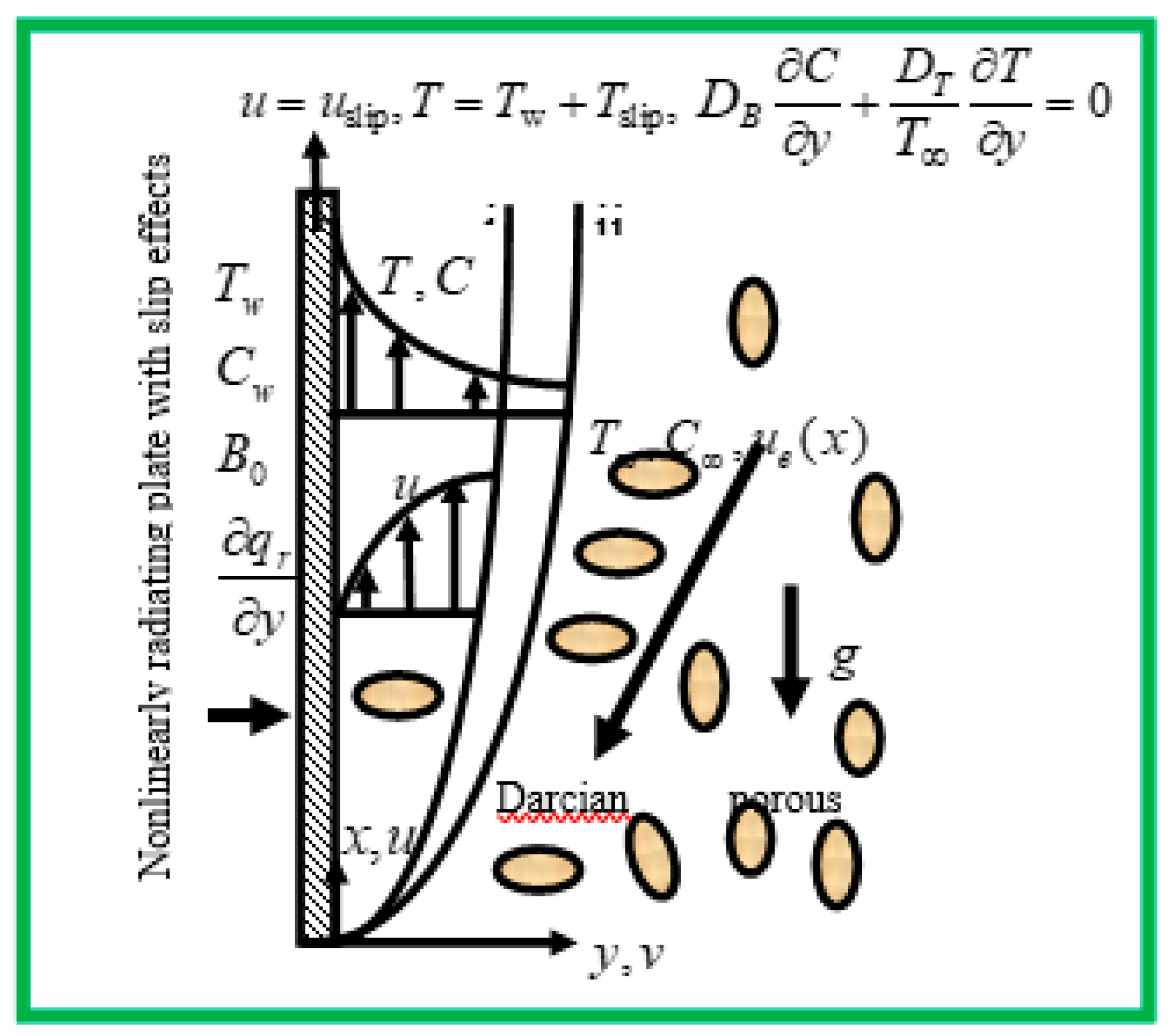

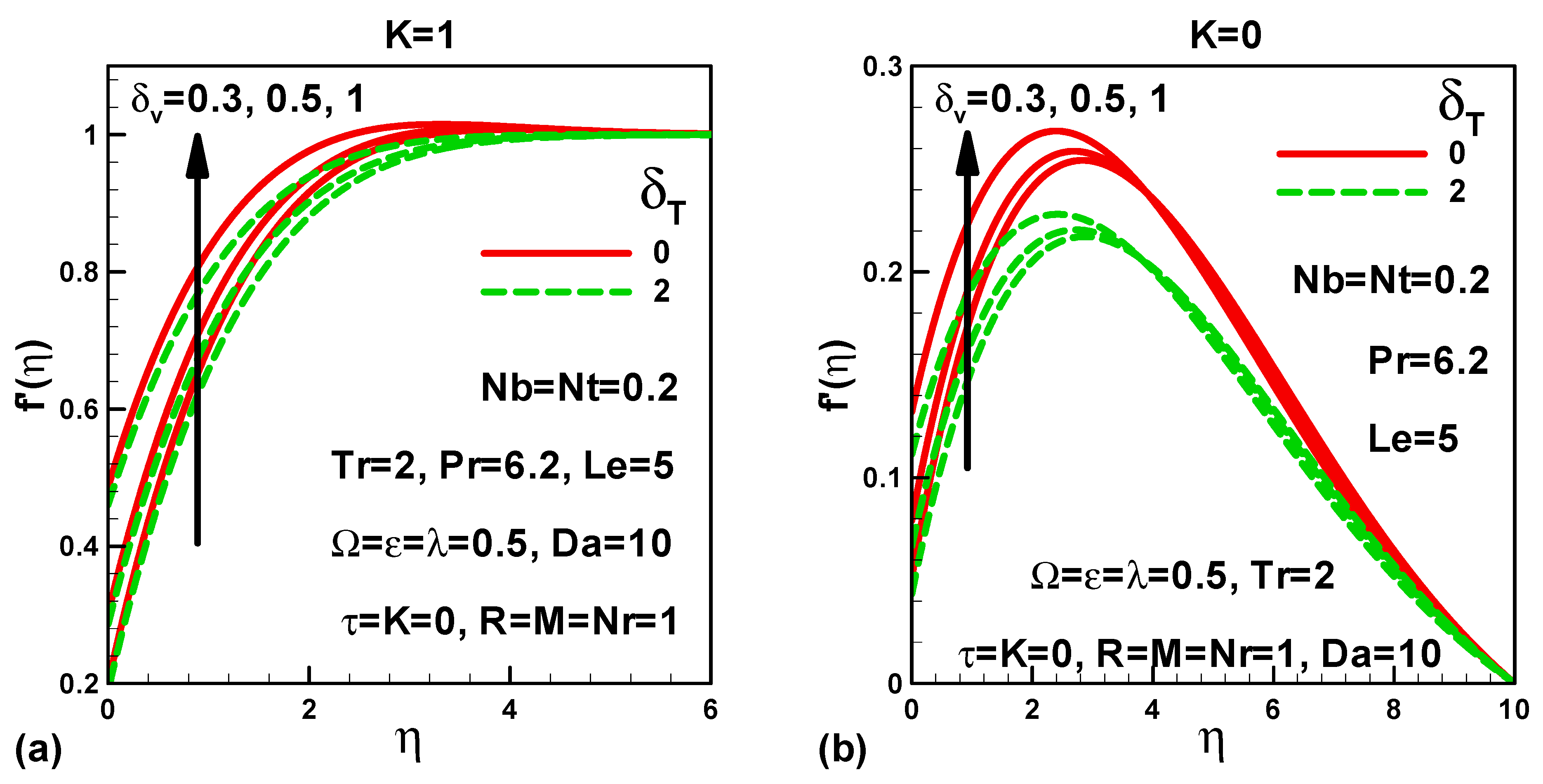
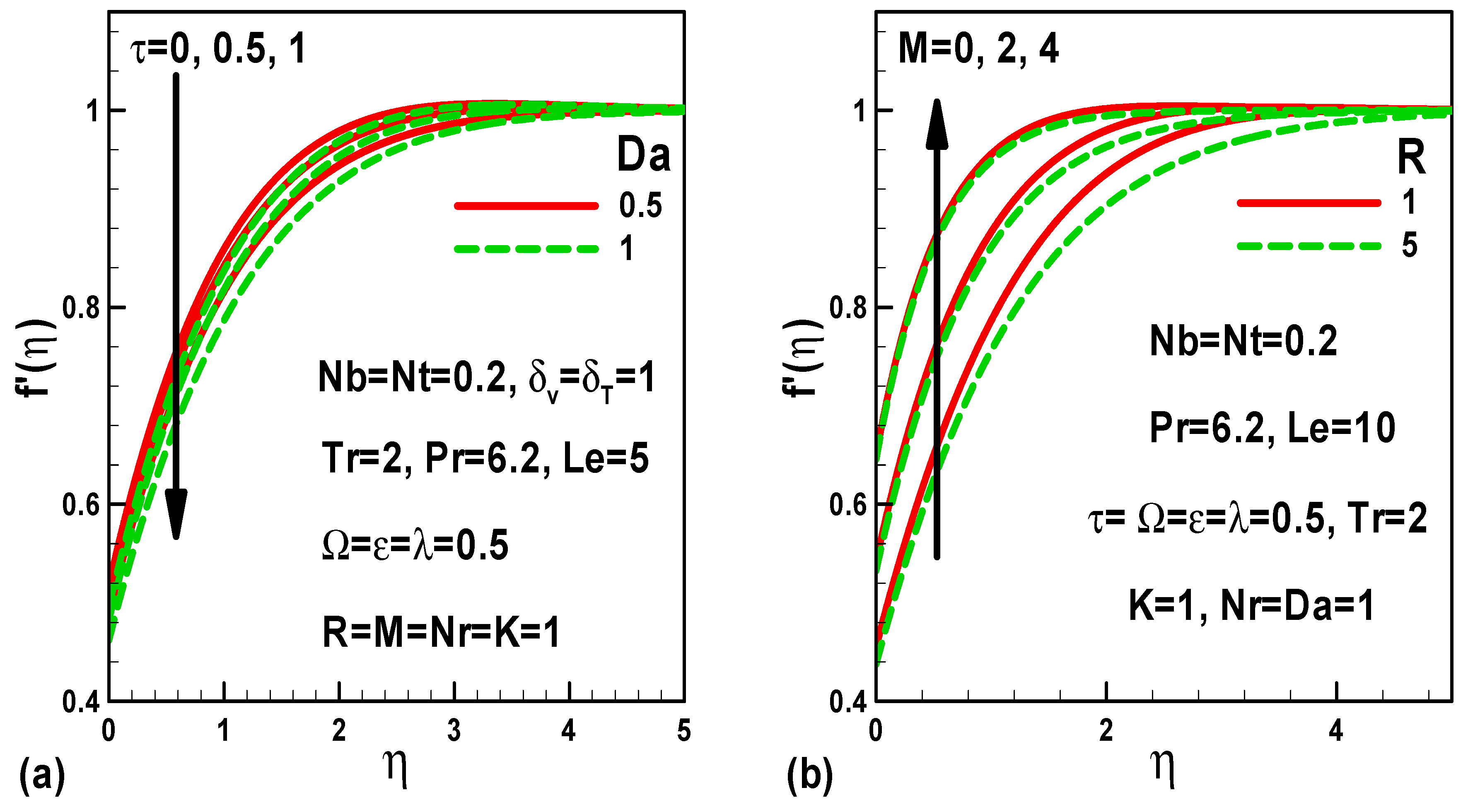
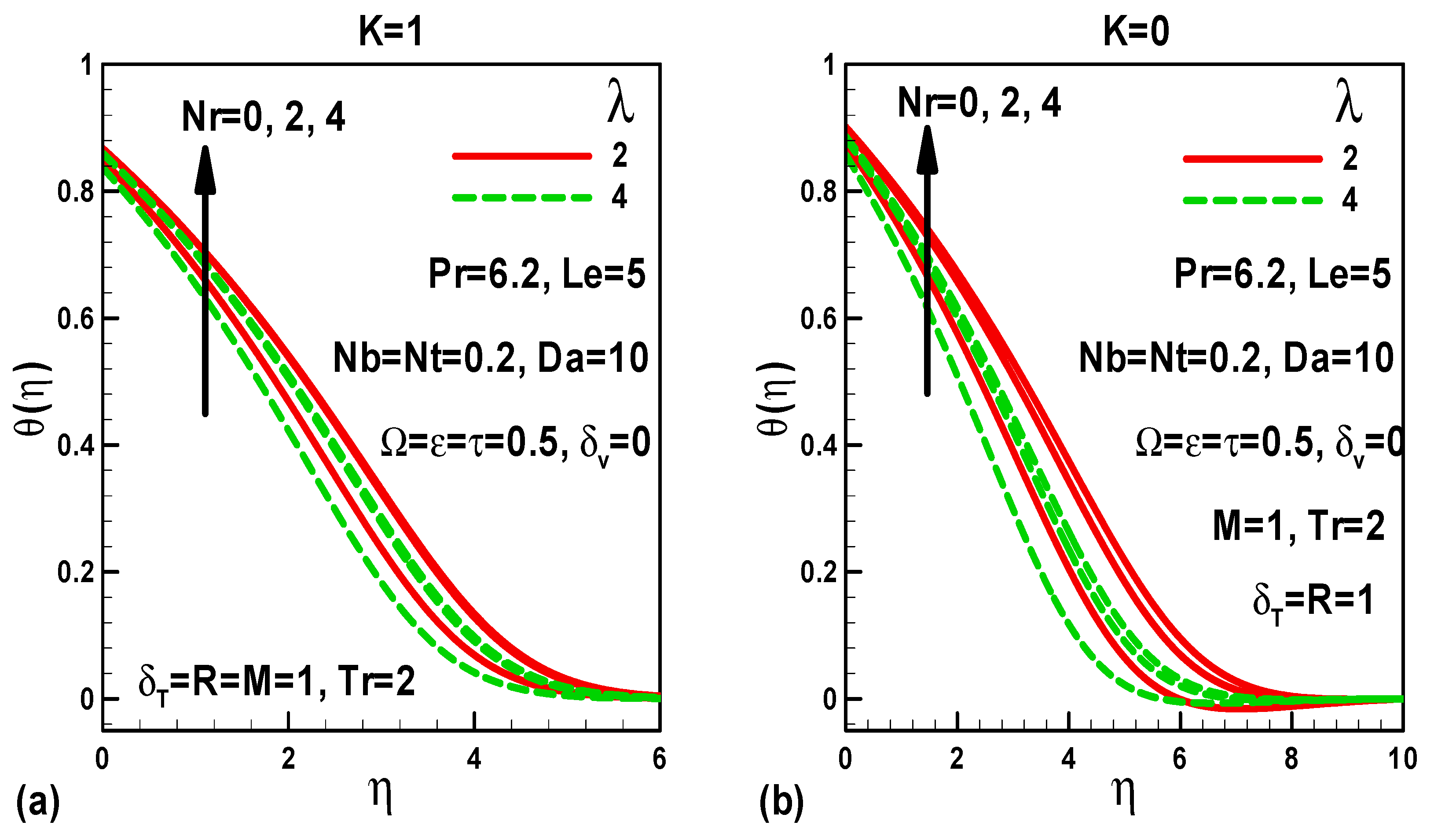
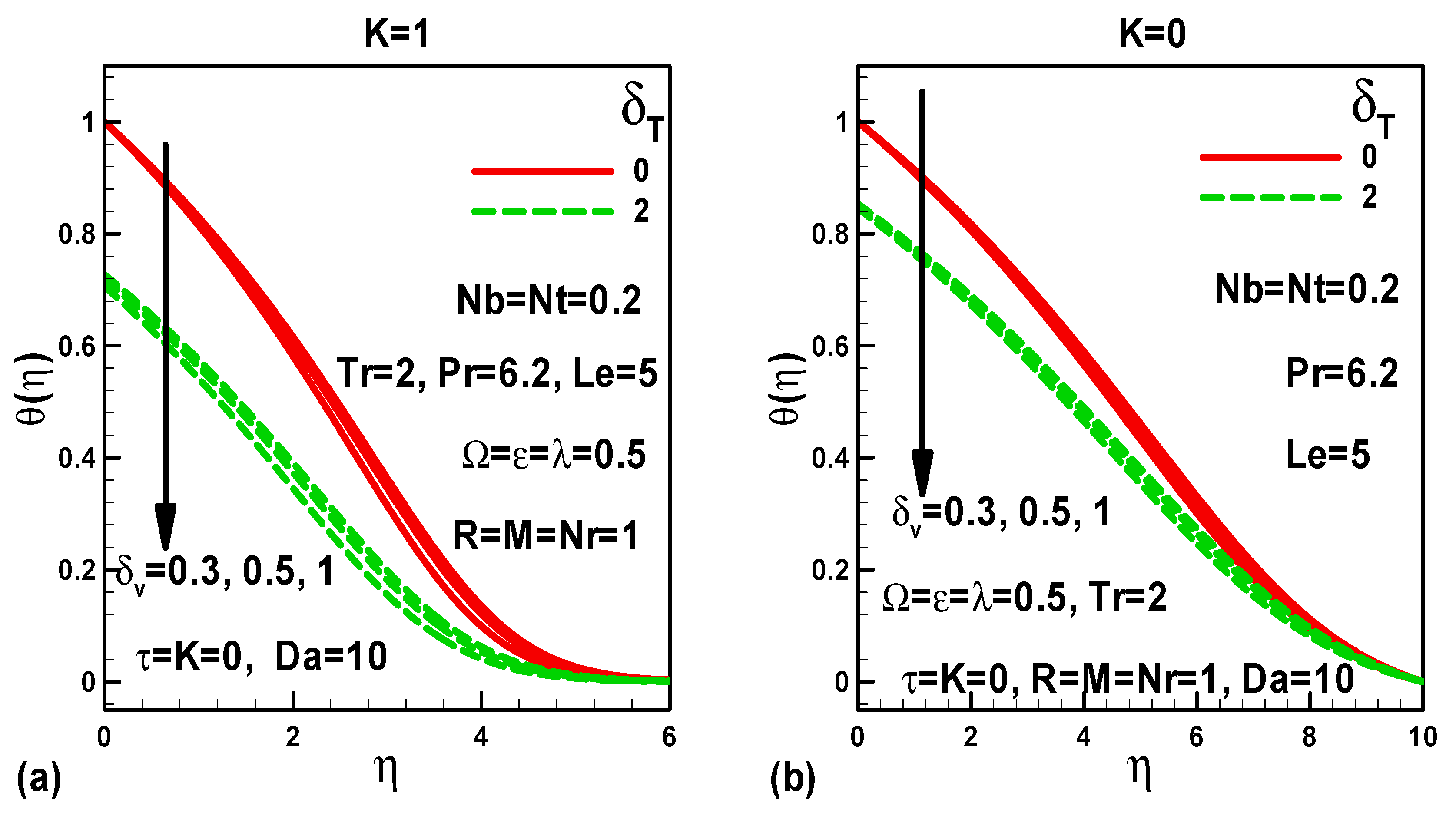

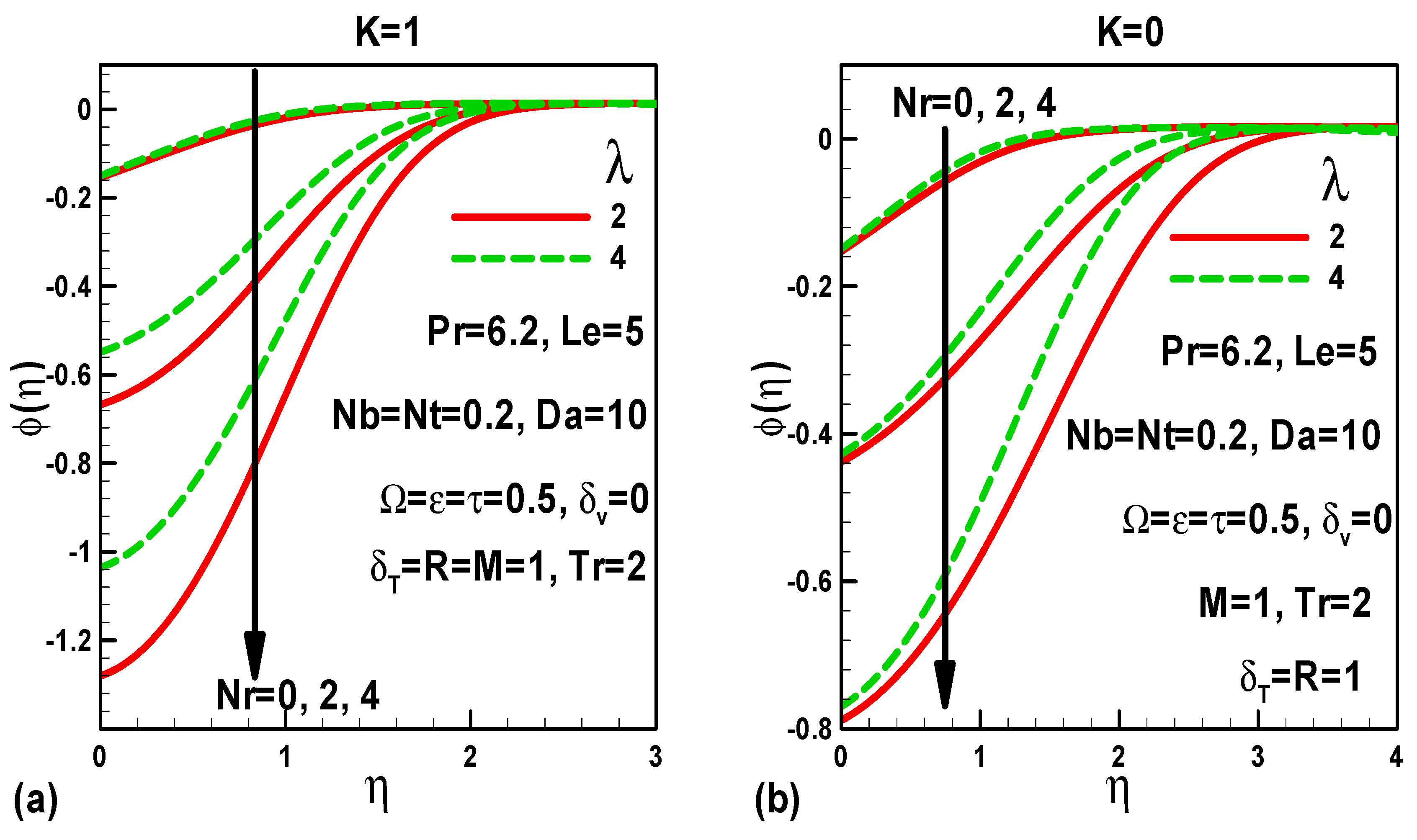
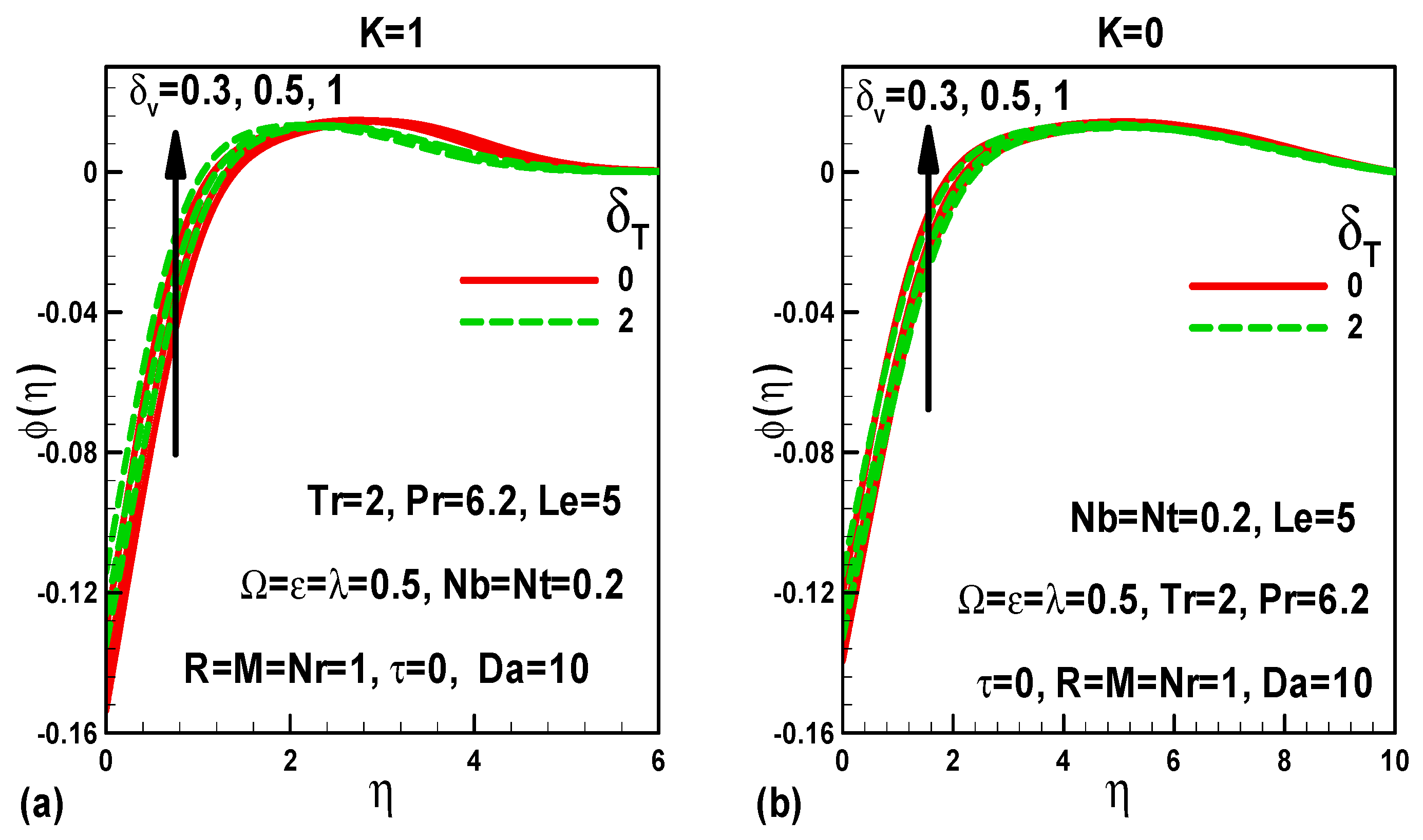

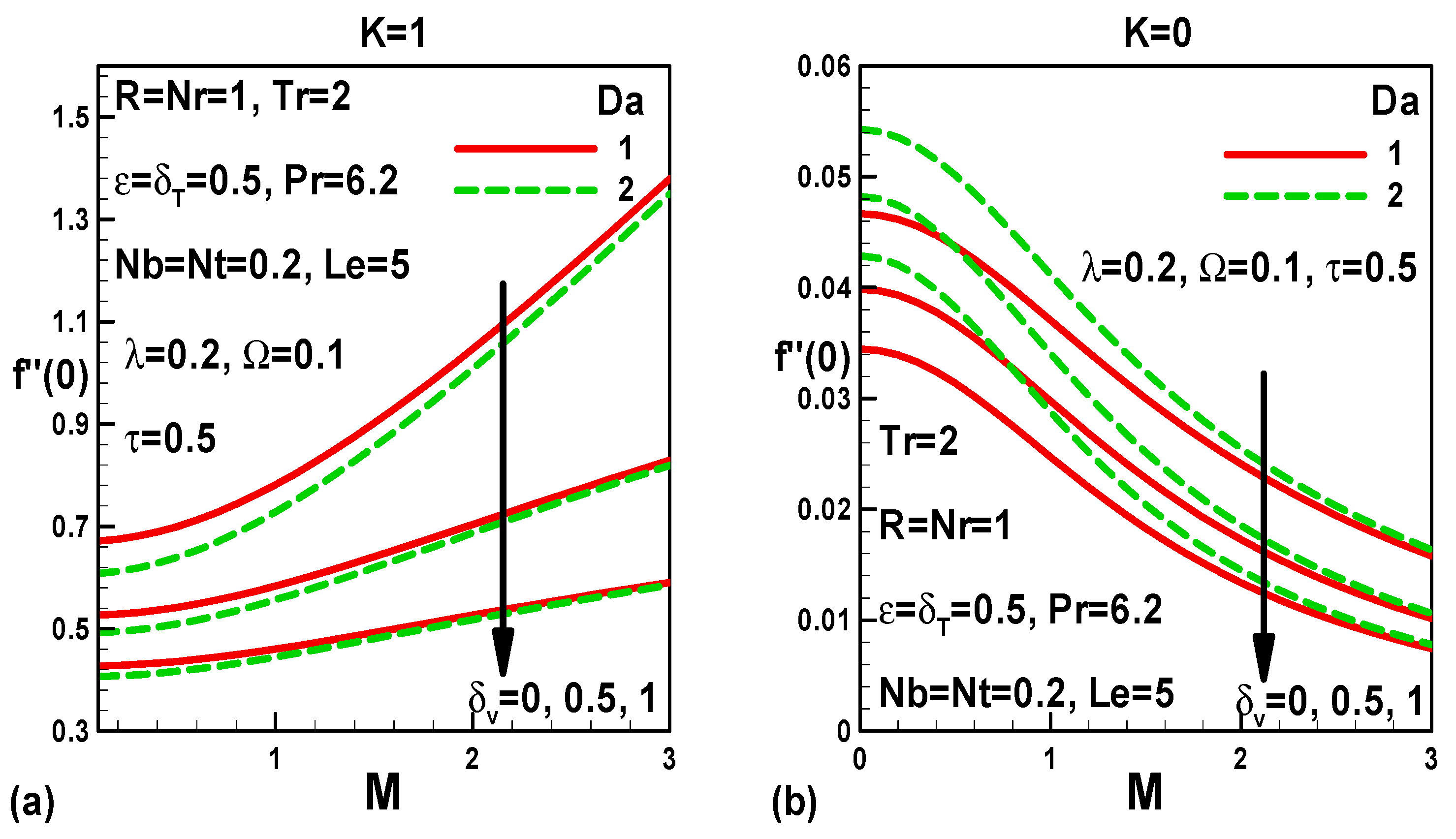
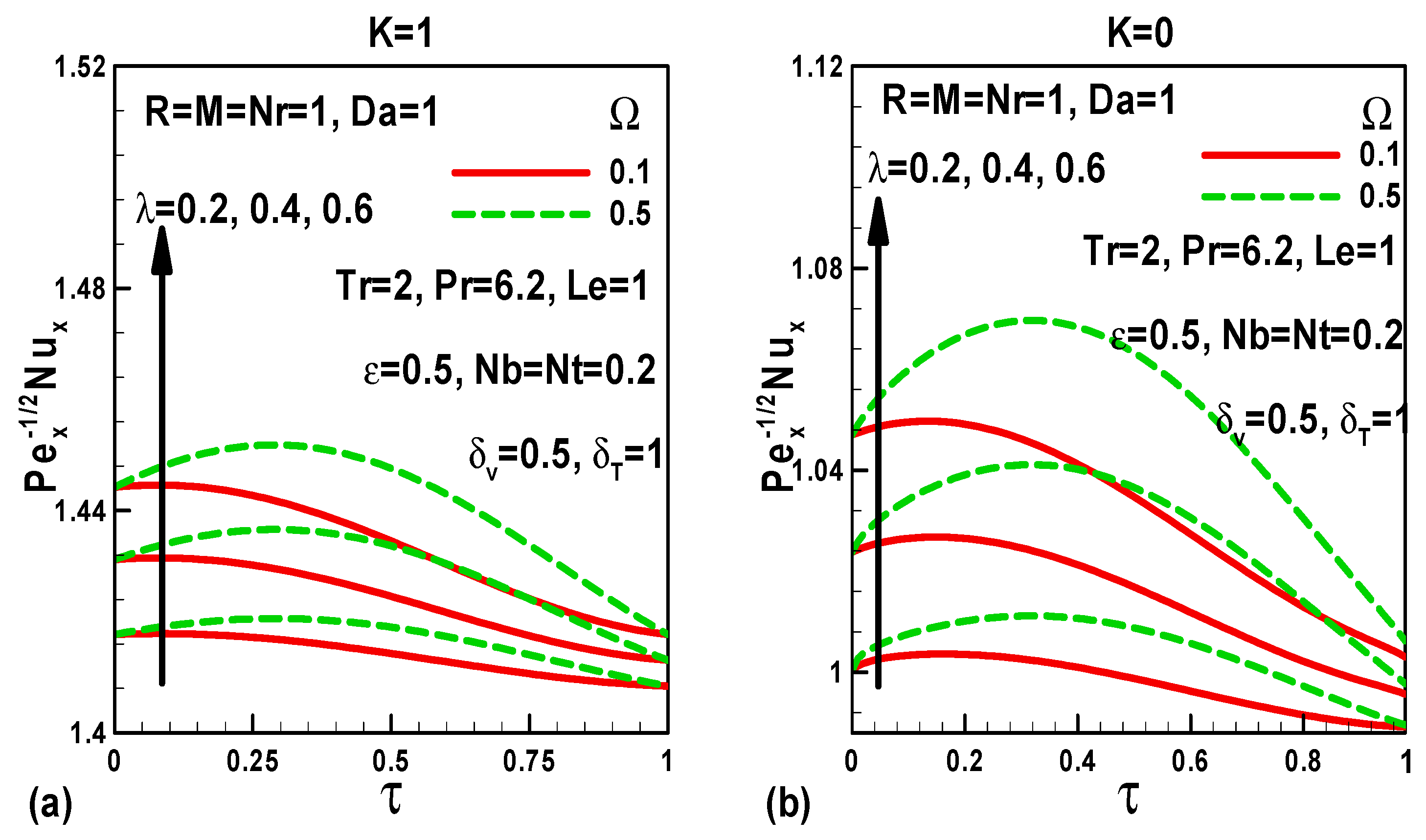
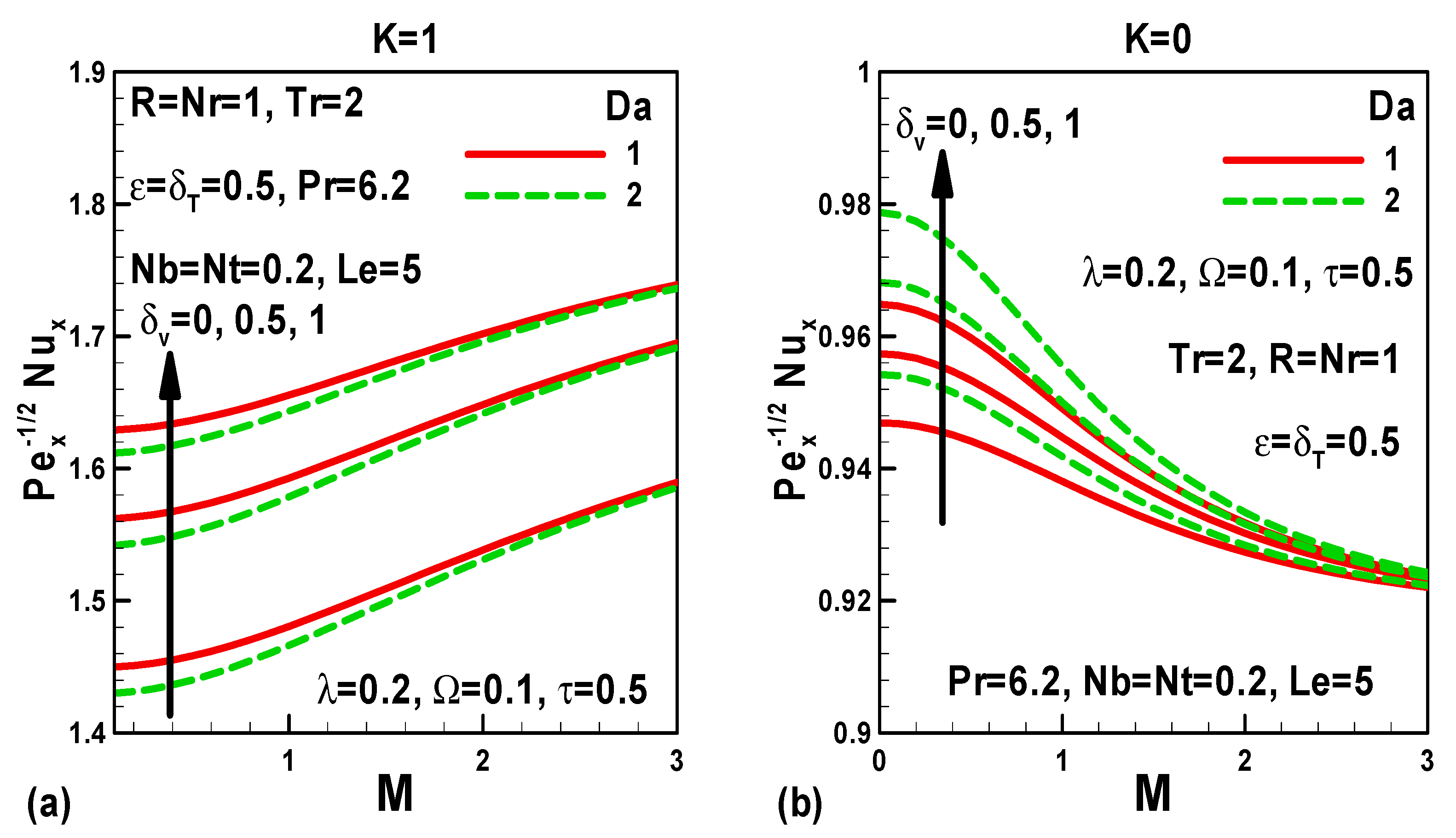

| M | Sparrow [47] | Ariel [48] | Yih [44] | Present Results |
|---|---|---|---|---|
| 0 | 1.231 | 1.233 | 1.233 | 1.233 |
| 1 | 1.584 | 1.585 | 1.585 | 1.585 |
| 2 | 2.345 | 2.347 | 2.346 | 2.347 |
| 5 | - | 5.148 | 5.148 | 5.148 |
| 10 | - | 10.075 | 10.075 | 10.075 |
| Pr | Sparrow [47] | Lin [49] | Yih [44] | Present |
|---|---|---|---|---|
| 0.001 | - | 0.025 | 0.024829 | 0.025 |
| 0.01 | 0.076 | 0.076 | 0.075973 | 0.076 |
| 0.1 | 0.219 | 0.2196 | 0.219503 | 0.219 |
| 1 | 0.570 | 0.5706 | 0.570465 | 0.570 |
| 10 | 1.349 | 1.339 | 1.338796 | 1.338 |
| 100 | - | 2.986 | 2.986329 | 2.975 |
| 1000 | - | 6.529 | 6.529137 | 6.519 |
| 10,000 | - | 14.158 | 14.158 | 14.142 |
© 2020 by the authors. Licensee MDPI, Basel, Switzerland. This article is an open access article distributed under the terms and conditions of the Creative Commons Attribution (CC BY) license (http://creativecommons.org/licenses/by/4.0/).
Share and Cite
Uddin, M.J.; Khan, W.A.; Bég, O.A.; Ismail, A.I.M. Non-Similar Solution of G-jitter Induced Unsteady Magnetohydrodynamic Radiative Slip Flow of Nanofluid. Appl. Sci. 2020, 10, 1420. https://doi.org/10.3390/app10041420
Uddin MJ, Khan WA, Bég OA, Ismail AIM. Non-Similar Solution of G-jitter Induced Unsteady Magnetohydrodynamic Radiative Slip Flow of Nanofluid. Applied Sciences. 2020; 10(4):1420. https://doi.org/10.3390/app10041420
Chicago/Turabian StyleUddin, M.J., W.A. Khan, O. Anwar Bég, and A. I. M. Ismail. 2020. "Non-Similar Solution of G-jitter Induced Unsteady Magnetohydrodynamic Radiative Slip Flow of Nanofluid" Applied Sciences 10, no. 4: 1420. https://doi.org/10.3390/app10041420
APA StyleUddin, M. J., Khan, W. A., Bég, O. A., & Ismail, A. I. M. (2020). Non-Similar Solution of G-jitter Induced Unsteady Magnetohydrodynamic Radiative Slip Flow of Nanofluid. Applied Sciences, 10(4), 1420. https://doi.org/10.3390/app10041420





